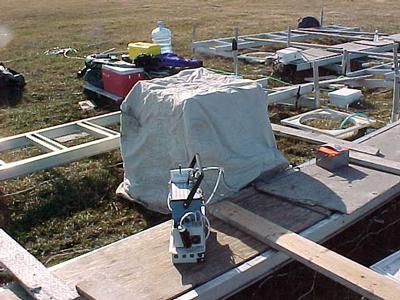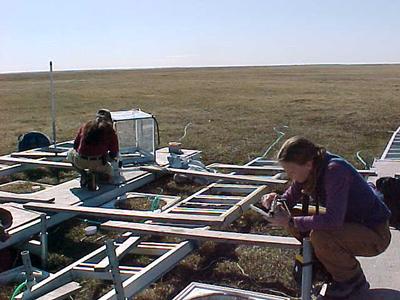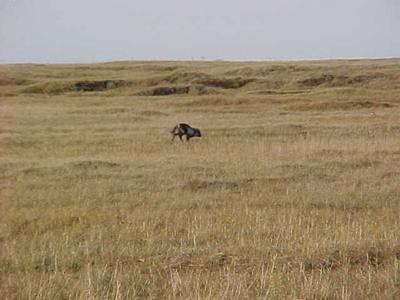2 July, 2001
Monday
Our second diurnal runs 24 hours today from midnight to midnight. The
four of us each have a 6 hour shift starting with Michelle, midnight to 6,
me, 6am to noon, Glen, noon to 6 pm and Lety, 6pm to midnight. We all
went out at midnight to carry out the equipment and have a brief refresher
course. The sun was bright and no wind. There seems to be a
high-pressure ridge stalled on top of us and itís providing us perfect
weather. Far cry from last time when we had snow flurries, drizzle and
wind!
Leaving Michelle out there, we came back to the lab and I managed a few
hours sleep before my shift. I arrived at the site, along with the fox,
and started taking measurements with the LiCor. Michelle said the
equipment was working better than last time and I found the same to be
true. In the weeks between this and the first diurnal we had sealed the
chambers more and taped the cuvette in a different way. The leaks were
minimized this time and it made for easier and more accurate
measurements.
At each plot we place the cuvette on the bases around the chamber,
securing it with bungi cords. The sealed chamber creates a closed system
allowing us to measure the CO2 gas within. As the air passes through the
LiCor it measures and displays the readings on the instrument face. We
have an acceptable range of readings we work with. If the numbers are
not within that range we re-take the measurement. This first
measurement, taken under light conditions, is for photosynthetic
processes. While the sun is out the plants are taking in CO2 and making
sugars. The second part of the task is to cover the cuvette to simulate
darkness when plants are undergoing respiration and giving off CO2. Once
again we have a range of readings to look for and if the measurements fall
within that range we go on to the next chamber. The goal of a diurnal is
to sample as many plots as possible during your shift. The more data
points the more accurate and better looking the graph. Glen will use the
data to generate graphs of the carbon flux.
My shift progressed with no problems and Iíd look up every so often and
see the fox in the distance scaring up the birds and what ever else was
there looking for food I suppose. The foxís coat is dark now making her
(?) appear more doglike than before when her coat was pure white. The
lemmings are beginning to come above ground though it might be a scant
year. I was hoping to see more lemmings because more lemmings mean more
snowy owls. Itís early and within the next week more should be happening.
The numbers of birds have increased, more small flocks of ducks can be
seen and the sounds of gunshots have also increased along with them.

Measurements have to be taken at each plot in sun light (photosynthesis) and in darkness (respiration) which we simulate by covering the cuvette.

Glen, starting his 6 hour shift, with the cuvette and Erika taking reflectance measurements at the site at noon.

We're beginning to think of the fox as our mascot. I showed up for my shift at 6am as did the fox. She (?) stayed for about 3 hours scaring up birds and hunting for breakfast. This morning she never came close though, she stayed out about 200 yards.
Contact the TEA in the field at
.
If you cannot connect through your browser, copy the
TEA's e-mail address in the "To:" line of
your favorite e-mail package.
|
